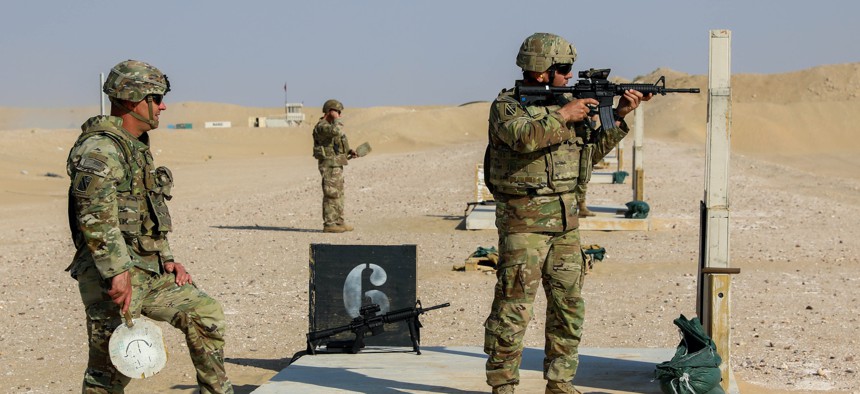
U.S. Army National Guard Capt. Joshua Cobb, assigned to Headquarters and Headquarters Battery, Task Force Iron Valor, spots for Capt. Nathan Davis, assigned to Bravo Battery, TF Iron Valor, as he shoots during his individual weapon qualification at Udari Range Complex, Kuwait on October 26, 2021. U.S. Army National Guard / Sgt. Kyle Burks
Diplomacy Is the Key to Reducing US Forces in the Mideast
The Pacific pivot need not reduce Middle East security—if the U.S. can get its partners on board.
U.S. military posture is a perfect example of the interdependence between defense strategy and foreign policy. Defense professionals in the Pentagon can come up with the best ideas for where and how the United States should station its troops and military assets overseas, but without the necessary U.S. diplomacy to secure security agreements or understandings with global allies and partners, those concepts will not be implementable.
The more enduring, robust, and predictable those bilateral (and multilateral) relationships are, generally, the more flexibility is afforded for U.S. posture. Thus, U.S. forces stationed on the territory of close treaty allies such as the United Kingdom, South Korea, Japan, and Australia enjoy greater flexibility for training, exercises, and even re-stationing than those deployed in other countries.
In the Middle East, however, the United States has relatively less latitude and room for creativity when it comes to its posture, largely because many of its regional partners insist on a visible and continuous U.S. military presence on their territory.
A primary reason why Mideast security partners have such strong preferences is because unlike America’s European and Asian allies, they don’t have legally binding mutual defense treaties with the United States. This fixation on a physical U.S. presence, which has only heightened in recent years because of fears of U.S. desertion, is understandable because it is the closest thing they have to a formal U.S. commitment to their defense.
The Biden administration’s just-released Global Posture Review will not enact a massive shift of U.S. military assets from the Middle East to other priority regions. However, consistent with the forthcoming National Defense Strategy, the review assumes that the pressures for a greater U.S. military presence in the Indo-Pacific to support Washington’s strategic competition with China will, inevitably, entail greater movement—though still modest—of American forces away from the Middle East.
Partners such as Saudi Arabia, the United Arab Emirates, and others don’t want the United States to further reduce its military footprint in the region because they believe this will weaken deterrence and embolden Iran. The United States, on the other hand, believes it is relatively over-invested militarily in the Middle East and must free up some of its forces to better deter China in the Indo-Pacific.
On the surface, it sounds like an unsolvable dilemma. But in reality, it isn’t. As we argued in 2015, the conversation about the future of U.S. military posture in the region, and elsewhere, should not start with numbers of American troops, aircraft carriers, fighter jets, or missile-defense batteries.
The emphasis should always be on military effectiveness and how best to achieve the stated objectives of the National Defense Strategy. In other words, posture planning should be strategy-driven and capabilities-based, not the result of random moves that look good in isolation.
For the purposes of U.S. posture in the Middle East, the most effective and efficient way to counter terrorists, deter Iran, and fight Iran if deterrence fails is by erecting an integrated posture with regional partners, most crucially in the missile defense and maritime domains. U.S. forces should be postured to contribute to the self-defense of its regional partners, not assume that responsibility entirely, like it did in the past.
Integrated deterrence, which will be a core element of the new National Defense Strategy, is precisely what Defense Secretary Lloyd Austin highlighted in Manama on Nov. 20. Though a sound strategic concept and priority, integrated deterrence is extraordinarily difficult to implement in the real world, especially in the Middle East.
Strengthening the key U.S. partnerships in the region will take serious diplomatic efforts, because it will require doing things that Arabs and Americans have never done before, including creating highly integrated consultative mechanisms and conducting joint contingency planning vis-à-vis Iran. In this case, integrated deterrence means first and foremost tightly orchestrated military efforts with the exercise of other instruments of national power across U.S. departments and regional partners’ relevant national security ministries.
Those regional partners have a say in what happens in the U.S. nuclear negotiations with Iran, and they have military capabilities, too. It’s about time Washington registers their security interests, which it failed to do before signing the 2015 Joint Comprehensive Plan of Action, and incorporates their growing military power into its strategic approach to the region.
Once those processes—especially those related to integrated deterrence—start to develop and mature, regional partners will probably be less focused on the raw number of American military forces in the region, and stop or at least reduce their hedging towards China and Russia. Only then will the United States acquire the posture flexibility it covets in the Middle East to pursue its challenging priority in the Indo-Pacific.
Bilal Y. Saab is Senior Fellow and Director of the Defense and Security Program at the Middle East Institute and author of the forthcoming book Rebuilding Arab Defense.
Barry Pavel is Senior Vice President and Director of the Scowcroft Center for Strategy and Security at the Atlantic Council.
NEXT STORY: Ending Strategic Ambiguity Won’t Help Taiwan




